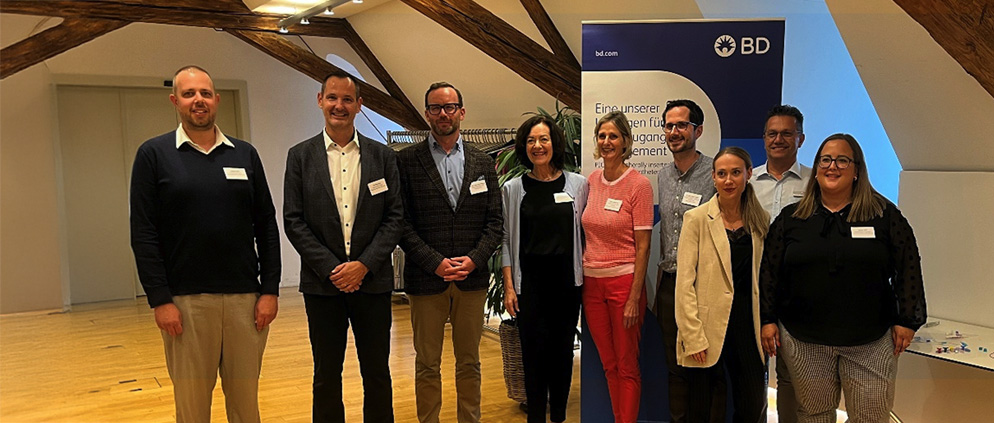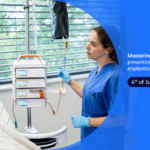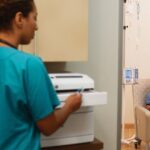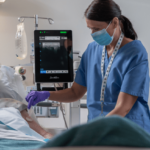PICC roundtable: «There are certain tricks and tips that you need to know»
PICC catheters provide central venous access through a peripheral vein in the upper arm. For intravenous therapies, they offer an alternative to other central venous catheter systems, which can help minimize hospital stay duration.1-3 Medical and nursing experts gathered at the first Bern PICC Roundtable on September 5, 2024, to discuss the insertion and application of PICCs from various professional perspectives.
Peripherally inserted central venous catheters (PICC) were developed in the 1970s and have since evolved in terms of materials and application techniques.2,4 Unlike other central venous catheters, the PICCs are inserted through an upper arm vein, with the tip of the catheter positioned in the superior vena cava before the right atrium of the heart.5 PICCs are used for various indications: inpatient and outpatient antibiotic or chemotherapy treatments, as well as other intravenous therapies, can be administered through them. They are also suitable for contrast agents and the measurement of central venous pressure and can remain in the body for as long as needed.3 The insertion can be done with ultrasound guidance with subsequent radiological tip confirmation under fluoroscopy for tip visualisation, or using an electrocardiogram (ECG) as a tip confirmation system (TCS).3, 6
At the first Bern PICC Roundtable on September 5 at the Generationen haus in Bern, discussions were held on the advantages of insertion using a TCS (Dr. Daniel Müller, Bürgerspital Solothurn), how nursing experts can independently insert PICCs (Dr. Alexander Rosenov, Hirslanden Beau-Site), and what needs to be considered for the maintenance and care of PICCs (Janine Galli, BD). The roundtable was moderated by Katharina Boshart, President of the National Experts for Vascular Access and Maintenance (NEVAM). Experts from the fields of medicines, nursing, Spitex, home care, and palliative care were among the other attendees of the roundtable in Bern.
PICC Insertion – Made easy
As one of the pioneers of ECG-based TCS application in Switzerland, Dr. Daniel Müller from the Vascular Center at Bürgerspital Solothurn presented the insertion of PICCs. «Initially, the PICC was placed under X-ray control in the operating room, which involved a lot of material and personnel effort», explains Dr. Müller. An ECG-based TCS as an alternative offers various advantages – the mobile device operates without radiation exposure, can be used directly at the patient’s bedside, and requires less time.3, 7 It uses a sensor placed on the chest to display the position of the magnetic tip at the distal end of the catheter and has internal and external ECG leads to confirm the correct position of the catheter tip relative to the heart. The position of the tip is displayed in real-time on the display interface, and the P-waves of the intracavitary ECG progressively increase as the catheter tip approaches the cavoatrial junction.3, 7
Since the first PICC insertion with the ECG-based TCS about 8 years ago, Dr. Müller’s team has experienced a steep learning curve and is now very proficient. 90% of patients at Bürgerspital Solothurn receive their PICCs in a specially equipped consultation room, and only in 3-4% of cases is a control X-ray necessary. Dr. Müller sees challenges in localization mainly with COPD, overweight, and underweight patients.8 «It’s not difficult, but there are certain tricks and techniques you need to know», summarizes Dr. Müller regarding PICC catheter insertion.
Empowerment and Relief Hand-in Hand
Dr. Rosenov speaks in his lecture about the advantages of PICC insertion by non-medical personnel: The nursing staff is often also responsible for pre- and post-care and can thus accompany patients more comprehensively. Additionally, the competence of nursing experts is expanded to include a procedure that is technically relatively simple but must be well-practiced.9 «The intervention risk is low, but you need to know the technique well», says Dr. Rosenov. The legal aspect in Switzerland stipulates that PICC insertion is a delegated medical activity, and the medical duty of disclosure applies. Thus, the status quo in Switzerland is that PICCs are mostly inserted by a doctor.9 In his clinic, however, Dr. Rosenov has now initiated fluoroscopy-guided PICC insertion by nursing experts. To enable this, experienced nurses complete an internal documented special training at a high level, which they finish with a certificate valid for one year. The responsibility remains with the doctor in this case as well.9 Dr. Rosenov says: « There needs to be a discussion about legal norms and personal responsibility».
In other hospitals, PICC insertion is rarely delegated to nursing experts. An exception is the Ente Ospedaliero Cantonale (EOC) in Ticino, where PICC are inserted in the patient’s bed using an ECG-based TCS.10 To enable this nationwide, structured training is necessary, through which nursing staff can officially acquire the competence for PICC insertion. All participating experts also see the time aspect as an advantage of this empowerment: depending on the hospital, patients sometimes wait several days for an appointment to insert the intravenous access. A present nurse comments: «There needs to be the possibility to perform PICC insertions quickly and with low barriers».
Attending Doctor: «What works in Ticino could also relieve hospital staff in Bern, but what about the responsibility? This question must be clarified before something like this can be expanded in Bern, and nursing must also be allowed to bill independently».
Attending Nurse: «This empowerment means more responsibility for nursing, but also relief for doctors. It is good to know that there is always a doctor in the background to discuss problems – that provides security. Technically, the insertion of a PICC catheter is simple, but in practice, there can always be situations where a doctor is needed».
«Flushing, flushing, flushing …»
Maintenance & Care for intravenous access begins with the selection of the right catheter. Product providers offer digital solutions that specify important parameters of the medications to be administered along with recommendations for suitable catheter characteristics.10 Flushing is central to PICC care. Always use sufficiently large syringes to avoid overpressure, and after parenteral nutrition or blood sampling, it is essential to flush with 2 x 10 ml of physiological saline solution.11
« Flushing makes everyone’s work easier», says Janine Galli at the beginning of her presentation. PICC catheters with clamps should generally be flushed every 12 hours (even when used with a connector), while catheters with valves only need to be flushed every 7 days.11, 12 The preference is clearly for pulsating flushing, which in studies was able to dislodge 90% of proteins within 8 seconds compared to continuous flushing, which dislodged 80% of proteins in the catheter within 24 hours.11, 13
In case of dislocation, PICC should never be pushed further in, as this poses a high risk of infection. In the event of catheter migration, always consult a doctor. The first dressing check should be done 24 hours after PICC insertion. Usually, a change is necessary; it is recommended to change it every 7 days thereafter.14 It is recommended to use a connector with PICC to create a closed system. The catheter, which can remain in place for a long time, is thus preserved, while the connector can be changed every 7 days.15 For comprehensive hygiene, the connector can be sealed with disinfectant caps, which also ensure germ-free conditions for up to 7 days.16 Katharina Boshart from NEVAM says: « The connector in combination with the disinfectant cap has ushered in a new era in intravenous access, especially in terms of safety». The PICC can be removed while lying down and without exertion after the puncture site has been thoroughly cleaned.
In the «PICC-Manual», which is given to patients as a kind of logbook, details of the insertion and treatment process are recorded. This information is essential for further care, for example by Spitex after leaving the hospital with a PICC catheter. During the exchange among participants, important improvements for communication at these interfaces were discussed. For example, the importance of the «PICC-Manual» can already be discussed with patients during insertion. A universally defined approach to flushing, position control, dressing changes, and the necessary materials is desirable and is already being worked on with the support of NEVAM.
Conclusion
An ECG-based TCS enables quick and uncomplicated installation and uncomplicated insertion and very precise localisation of the catheter tip during PICC insertion.3 The procedure is less stressful for patients and insertion is possible on a couch, in bed and in the intensive care unit. In addition, the PICC insertion can also be performed by trained nursing staff.3, 7 In the Bern area, the participating experts benefited from the exchange at the roundtable and take many suggestions back to everyday clinical practice.
References
- Heath M et al. Improving Appropriate Use of Peripherally Inserted Central Catheters Through a Statewide Collaborative Hospital Initiative: A Cost-Effectiveness Analysis. The Joint Commission Journal on Quality and Patient Safety, 2024, https://doi.org/10.1016/j.jcjq.2024.04.003
- Bing S et al. PICC versus midlines: Comparison of peripherally inserted central catheters and midline catheters with respect to incidence of thromboembolic and infectious complications. The American Journal of Surgery, 2022. 223(5): p. 983-987.
- Dale M et al. Sherlock 3CG(®) Tip Confirmation System for Placement of Peripherally Inserted Central Catheters: A NICE Medical Technology Guidance. Appl Health Econ Health Policy, 2016. 14(1): p. 41-9.
- Hoshal VL, Jr. Total Intravenous Nutrition With Peripherally Inserted Silicone Elastomer Central Venous Catheters. Archives of Surgery, 1975. 110(5): p. 644-646.
- Michaela Hans, Professor Dr. med. Bernhard Gebauer: Pflegeleitfaden PICC / Peripher Inserted Central Catheter / periphere zentral-venöse Katheter, Institut für Hygiene und Umweltmedizin der Charité Berlin, April 2013.
- BD-102631 Sherlock 3CG_2B System Flyer DE.
- Tomaszewski KJ et al. Time and resources of peripherally inserted central catheter insertion procedures: a comparison between blind insertion/chest X-ray and a real time tip navigation and confirmation system. Clinicoecon Outcomes Res, 2017. 9: p. 115-125.
- Dr. med. Daniel Müller, PICC Implementation – How I do it: SiteRite/ Sherlock 3 CG. Berner PICC Roundtable, 05.09.2024.
- Dr. med. Alexander Rosenov, Empowerment – PICC Einlage durch HCP (Pflegefachpersonen/MTRA). Berner PICC Roundtable, 05.09.2024.
- Becton, Dickinson, and Company. (2022, 9. April). BD Infusate Companion. App Store.https://apps.apple.com/us/app/bd-infusate-companion/id1617095127.
- PowerPICC Solo2 catheter RN. Instruction For Use.2016.0741199 1602R.
- PowerPICC Catheter Technical Data Sheet. 2019.
- REF-15331 Vergleichende Analyse der Effektivität unterschiedlicher Spülmethoden bei IV-Kathetern. 2020. 2237_129513_162042.
- StatLockTMPICC StabilizationDevice, Introductionfor use. 2016.
- BD-54536 NFC Matrix GERMAN. 2022. 2237_190587_303360.
- BD-92257 BD PureHub Disinfecting Cap Brochure GSA.2023.2237_252547_395730.
This bibliography with peer-reviewed material and the websites where the material is provided are for your information only and do not imply verification or endorsement of the material or an association with the operators. Third-party sources (and the websites they refer to) may contain information that is inaccurate, incomplete, or outdated. Your access and use of third-party websites (and any websites they link to) is entirely at your own risk.
This presentation was developed by the presenter, and the results, interpretations, and conclusions contained or expressed herein do not necessarily reflect the views of BD. To the extent that this presentation relates to specific products, these products should always be used in accordance with the relevant instructions for use and other product documentation. This content may not be copied or distributed without the consent of the copyright holder. For further information, please contact: GMB-EU-MDS@bd.com




